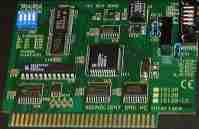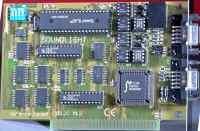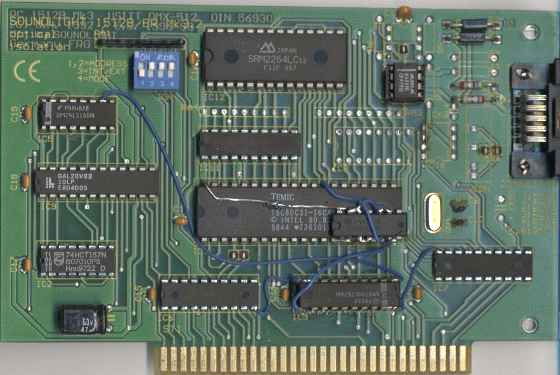SoundLight ISA family


The 1512 series from SoundLight including the Lightline
interface from Elrad magazine.
Hardware configuration
SLH1512A and SLH1512B-LC
For the Lightline, SLH1512A and SLH1512B-LC please set the jumpers
on the card as follows, where the switches 1 and 2 can be set as
described in the table below.

| 1 | 2 | Address |
|---|
| ON | ON | 0x100 |
| OFF | ON | 0x120 |
| ON | OFF | 0x140 |
| OFF | OFF | 0x160 |
Where ON is the upper position and OFF is the lower position.
SLH1512B and SLH1512C
If you have a SLH1512B or SLH1512C you have to set the jumpers on
the card as shown in the following picture, where switches 1 and 2
are to be set as decribed by the table below.
Some users had the expierience that their machine has crashed
for an unknown reason if the IO-Address has been set to 0x100.
If you have that same experience please check out another address
and send us a small note.

| 1 | 2 | Address |
|---|
| ON | ON | 0x100 |
| OFF | ON | 0x120 |
| ON | OFF | 0x140 |
| OFF | OFF | 0x160 |
Where ON is the upper position and OFF is the lower position.
SW4 is used to choose between the on-chip firmware and the
firmware load into the RAM. It must be set to ON because we
upload out own firmware that has some enhancements such as
the usage of interrupts if available, which speeds up things
a bit. SW3 on the SLH1512C is connected to an IO-Pin and can be
read by the firmware. Please make shure that it is set to the
ON position.
Hardware patches
Readback register
The SLH1512A, SLH1512B/LC and SLH1512B can be extended to have a
one byte readback register to the host. Connect the outputs to
the ISA-Data-Bus and the Inputs to P0, this can be done by
placeing the 74574 in oposite direction on top of the bus driver
(the 74245). Connect the -OE pin of the 74574 to pin 10 of the
74155 (2Y1). Connect the -CP pin to the output of a NAND as
shown above. This hack can only be done for the old style cards,
that does not have the SMD chips. It's more hard to make this
on the SMD based cards.
If you make a read to BaseAddress+3 you read out the content of
the Latch.
So in one bit you can for example store the interrupt status
that tells you that an interrupt comes from that card. In that
way you are able to implement interrupt sharing.
This hardware enhancement is autodetected and used by the
DMX4Linux drivers.
.-----7400-----. +5V
| +---+ | |
A15 AC1/pin28 ----------| | +------+------+
+---+ | & |O--|-CP Vcc -OE|----- IC5/pin10 (74155)
.-| |O--| | | |
-WR IC5/pin10 -+ | & | +---+ |-------------|
`-| | | |
+---+ | 74575 |
P0 o----| |----o ISA-D0
P1 o----| |----o ISA-D1
P2 o----| |----o ISA-D2
P3 o----| |----o ISA-D3
P4 o----| D Q |----o ISA-D4
P5 o----| |----o ISA-D5
P6 o----| |----o ISA-D6
P7 o----| |----o ISA-D7
| Vss |
+------+------+
|
GND

Interrupt/IRQ support
The SLH A,B,B/LC have interrupt support. To enable interrupts
you simply have to connect one(!) of the interrupt pads. SLH
A,B,B/LC only support IRQ 3 and 4, which are normally used by
the serial ports. You should disable the appropriate port
(Serial 1 uses IRQ4, Serial 2 uses IRQ3) and you have to declare
the choosen IRQ to be used by ISA cards in your bios. The new
SMD versions of these cards have support for IRQ 3,4,5,9. IRQ5
is uses by the second parallel port, thus free if you have only
one. IRQ9, which equals IRQ2, is normally not used. We recommend
using IRQ9. Please remember to adjust your bios settings, so
IRQ9 (or any other) is used by ISA cards.
If you have enabled the IRQ, it is autodetected and used by the
DMX4Linux driver automatically.
Disclaimer for the above Hardware patches
Don't do this unless you know what you are doing and do it on
your own risk. Neither the company Soundlight nor I, the author,
can be made responsible for this hack. It is just an idea how to
improve the cards.
|





